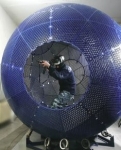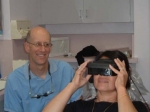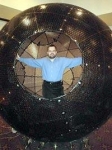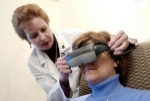Nov 23, 2005
VR training for safe street crossing of neglect patients
Disabil Rehabil. 2005 Oct 21;27(20):1235-44
Authors: Katz N, Ring H, Naveh Y, Kizony R, Feintuch U, Weiss PL
Abstract. Purpose. The goal of this study was to determine whether non immersive interactive virtual environments are an effective medium for training individuals who suffer from Unilateral Spatial Neglect (USN) as a result of a right hemisphere stroke, and to compare it to a standard computer visual scanning training.Method. Participants included 19 patients with right hemisphere stroke in two groups, 11 in an experimental group were given computer desktop-based Virtual Reality (VR) street crossing training and 8 in a control group who were given computer based visual scanning tasks, both for a total of twelve sessions, 9 hours total, over four weeks. Measures included: 1. Standard USN assessments, paper and pencil and ADL checklist; 2. Test on the VR street program; and 3. Actual street crossing videotaped. Testing was performed pre and post intervention.Results. The VR group achieved on the USN measures results that equaled those achieved by the control group treated with conventional visual scanning tasks. They improved more on the VR test and they did better on some measures of the real street crossing.Conclusions. Despite several limitations in this study the present results support the effectiveness of the VR street program in the treatment of participants with USN, and further development of the program.
16:05 Posted in Cybertherapy | Permalink | Comments (0) | Tags: Positive Technology, virtual reality
Nov 13, 2005
Development of a Virtual Reality System for the Rehabilitation of the Upper Limb After Stroke
Authors: Crosbie J, McDonough S, Lennon S, McNeill M
Virtual reality (VR) provides a three-dimensional computer representation of a real world or imaginary space through which a person can navigate and interact with objects to carry out specific tasks. One novel application of VR technology is in rehabilitation following stroke, particularly of the upper limb. This paper describes the development of a VR system for use in this field. This system gives the user the ability to interact with objects by touching, grasping and moving their upper limb.
21:25 Posted in Cybertherapy | Permalink | Comments (0) | Tags: Positive Technology, virtual reality
Nov 09, 2005
Virtual reality-induced neuroplastic changes in chronic stroke
Cortical reorganization and associated functional motor recovery after virtual reality in patients with chronic stroke: an experimenter-blind preliminary study
Arch Phys Med Rehabil. 2005 Nov;86(11):2218-23
Authors: Jang SH, You SH, Hallett M, Cho YW, Park CM, Cho SH, Lee HY, Kim TH
10:00 Posted in Cybertherapy | Permalink | Comments (0) | Tags: Positive Technology, virtual reality, cybertherapy
Nov 08, 2005
Regional brain activation evoked when approaching a virtual human on a virtual walk
Authors: Morris JP, Pelphrey KA, McCarthy G
Abstract. We investigated the necessity of biological motion for activation of the posterior superior temporal sulcus (pSTS) in circumstances in which the rapid approach of the observer to a virtual human induced the observer to make inferences about the characters intentions. Using a virtual reality environment, subjects experienced themselves walking towards a complex scene composed of animate and/or inanimate objects. During "person" trials, the scene contained a virtual human either making a simple gesture such as scratching his face (Study 1) or standing completely still (Study 2). During "object" trials, the scenes contained items such as furniture, a face portrait, and a clock, but not the virtual human. Using functional MRI to measure brain activity, we demonstrated strong activity in the pSTS while the observer approached the social scene, but only when the virtual human was making gestures. This result emphasizes the importance of biological motion in inferring the intentions of others.
17:25 Posted in Virtual worlds | Permalink | Comments (0) | Tags: Positive Technology, virtual reality
Promising results from internet-based self-help for depression
A study recently published by Andersson and co-workers in British Journal of Psychiatry has found that psychological treatment for depression, delivered over the internet, is reliable and effective. 
117 people with mild to moderate depression who met a number of inclusion criteria were included in this randomised controlled trial. The majority came from smaller cities, villages and places outside the larger cities (where university clinics are usually based). 36 participants in the treatment group and 49 in the control group completed post-treatment measures. In total the rate of withdrawal from the programme was 27%. The main reason given was that the treatment was too demanding. Thus the rates of withdrawal differed between the treatment group (37%) and the control group (18%).
It was found that the active treatment, which included standard cognitive-behavioural approaches and behavioural changes, resulted in decreased depressive symptoms immediately after treatment and at the six-month follow-up. There were also benefits in terms of anxiety symptoms and quality of life.
Reference
Andersson G, Bergstrom J, Hollandare F, Carlbring P, Kaldo V and Ekselius L (2005) Internet based self-help for depression: randomised controlled trial, British Journal of Psychiatry, 187, 456-461.
17:15 Posted in Cybertherapy | Permalink | Comments (0) | Tags: Positive Technology, virtual reality, cybertherapy
Nov 03, 2005
Benefits of activity and virtual reality based balance exercise programmes for adults with traumatic brain injury: Perceptions of participants and their caregivers
Brain Inj. 2005 Nov;19(12):989-1000
Authors: Thornton M, Marshall S, McComas J, Finestone H, McCormick A, Sveistrup H
21:45 Posted in Cybertherapy | Permalink | Comments (0) | Tags: Positive Technology, virtual reality, cybertherapy
Oct 31, 2005
Human responses to augmented virtual scaffolding models
Ergonomics. 2005 Aug;48(10):1223-42
Authors: Hsiao H, Simeonov P, Dotson B, Ammons D, Kau TY, Chiou S
This study investigated the effect of adding real planks, in virtual scaffolding models of elevation, on human performance in a surround-screen virtual reality (SSVR) system. Twenty-four construction workers and 24 inexperienced controls performed walking tasks on real and virtual planks at three virtual heights (0, 6 m, 12 m) and two scaffolding-platform-width conditions (30, 60 cm). Gait patterns, walking instability measurements and cardiovascular reactivity were assessed. The results showed differences in human responses to real vs. virtual planks in walking patterns, instability score and heart-rate inter-beat intervals; it appeared that adding real planks in the SSVR virtual scaffolding model enhanced the quality of SSVR as a human - environment interface research tool. In addition, there were significant differences in performance between construction workers and the control group. The inexperienced participants were more unstable as compared to construction workers. Both groups increased their stride length with repetitions of the task, indicating a possibly confidence- or habit-related learning effect. The practical implications of this study are in the adoption of augmented virtual models of elevated construction environments for injury prevention research, and the development of programme for balance-control training to reduce the risk of falls at elevation before workers enter a construction job.
18:10 Posted in Virtual worlds | Permalink | Comments (0) | Tags: Positive Technology, virtual reality
EMagin Z800 3DVisor Stereoscopic Headset for under $1000
via Extremetech
Good news for virtual reality therapy. eMagin offers stereoscopic headset for under $1,000.
The Z800 has 800x600 active matrix OLED displays including a pair of sharp OLED displays which supports 8 bits per pixel (16.67 million colors) and 200:1 contrast ratio. 
The price includes the head-tracker (six-degrees-of-freedom MEMS sensor, with independent gyroscopes and accelerometers for the X-Y-Z axes), a pair of stereo audio earbuds, and an integrated microphone. But the most interesting feature of the Z800 is that it is USB powered. This reduces the number of wires and gives the user more freedom of movement.
17:20 Posted in Cybertherapy | Permalink | Comments (0) | Tags: Positive Technology, virtual reality
Oct 28, 2005
Online support helps people with chronic illnesses cope
Via BBC news
Results of a review study conducted by Elizabeth Murray and co-workers from University College London suggest that the use of interactive websites can help people with chronic illnesses such as depression, heart disease and HIV/Aids.
 The review was based on a total of 24 studies involving 3,739 participants who all had chronic (long-term) health conditions. UCL researchers looked at these patients' use of interactive computer websites and programmes, which contained information services plus online support groups, chatrooms, or tailored advice based on a person's details, affected people with such chronic diseases.
The review was based on a total of 24 studies involving 3,739 participants who all had chronic (long-term) health conditions. UCL researchers looked at these patients' use of interactive computer websites and programmes, which contained information services plus online support groups, chatrooms, or tailored advice based on a person's details, affected people with such chronic diseases.The authors of the research found that interactive sites were of greater benefit to people than those with information alone, or not using sites at all. Moreover, researchers found that such sites made patients feel better informed, more socially supported, and helped them to improve self-efficacy - a person's belief in their ability to carry out potentially-beneficial actions.
13:35 Posted in Cybertherapy | Permalink | Comments (0) | Tags: Positive Technology, virtual reality, cybertherapy
Oct 26, 2005
Technological innovations in clinical assessment and psychotherapy
Psychother Psychosom. 2005;74(6):336-43
Authors: Emmelkamp PM
In this paper the application of computer technology and the use of the Internet in mental health care are critically reviewed. A number of on-line screening devices have been developed for anxiety disorders, mood disorders, and substance abuse disorders, with great potential for clinical practice. On line assessment is generally equivalent to clinical assessment. A number of studies have shown that self-help treatment programmes on stand-alone computers are as effective as routine clinical care. The Internet enhances the therapeutic possibilities of computers by offering feedback of therapists and more tailor-made treatment. A number of randomized clinical trials (RCTs) have shown that Internet-based treatment is more effective than no-treatment and as effective as face-to-face treatment. Research so far has been limited to anxiety disorders, burn-out, depression, headache, insomnia, tinnitus and obesity. Further, exposure through virtual reality has been found effective in a number of RCTs in specific phobias, but results with respect to the effects of the use of virtual reality techniques to other disorders are inconclusive. It is concluded that computer-driven assessment and treatment has many advantages and few disadvantages. A number of reasons are discussed which will preclude large-scale implementation of computer-driven assessment and therapy in the near future.
PMID: 16244509 [PubMed - in process]
16:05 Posted in Cybertherapy | Permalink | Comments (0) | Tags: Positive Technology, virtual reality, cybertherapy
Oct 22, 2005
Cognitive behavioral therapy for public-speaking anxiety using virtual reality for exposure
Authors: Anderson PL, Zimand E, Hodges LF, Rothbaum BO
This study used an open clinical trial to test a cognitive-behavioral treatment for public-speaking anxiety that utilized virtual reality as a tool for exposure therapy. Treatment was completed by participants (n=10) meeting the Diagnostic and Statistical Manual of Mental Disorders (DSM)-IV criteria for social phobia, or panic disorder with agoraphobia in which public speaking was the predominantly feared stimulus. Treatment was conducted by a licensed psychologist in an outpatient clinic. Treatment consisted of eight individual therapy sessions, including four sessions of anxiety management training and four sessions of exposure therapy using a virtual audience, according to a standardized treatment manual. Participants completed standardized self-report questionnaires assessing public-speaking anxiety at pre-treatment, post-treatment, and 3-month follow-up. Participants were asked to give a speech to an actual audience at pre- and post-treatment. Results showed decreases on all self-report measures of public-speaking anxiety from pre- to post-treatment, which were maintained at follow-up (n=8; all P<.05). Participants were no more likely to complete a speech post-treatment than at pre-treatment. This study provides preliminary evidence that a cognitive-behavioral treatment using virtual reality for exposure to public speaking may reduce public-speaking anxiety and suggests that further research with a controlled design is needed. Depression and Anxiety 0:1-3, 2005. (c) 2005 Wiley-Liss, Inc.
19:05 Posted in Cybertherapy | Permalink | Comments (0) | Tags: Positive Technology, virtual reality, cybertherapy
Oct 21, 2005
Virtual reality cue reactivity assessment in cigarette smokers
Cyberpsychol Behav. 2005 Oct;8(5):487-92
Authors: Bordnick PS, Graap KM, Copp HL, Brooks J, Ferrer M
Abstract. Drug craving has purportedly been linked to relapse and to substance use. For over two decades, cue reactivity has been a viable method to assess craving and physiological reactions to drug stimuli. However, traditional cue reactivity has faced the following limitations: austere situations or stimuli, lack of complex cues, lack of standardization, and limited generalization outside of the lab setting. In order to improve cue methodologies, a virtual  reality (VR) nicotine cue reactivity assessment system (VR-NCRAS) was developed and tested in a controlled experimental trial. Ten nicotine dependent smokers were exposed to VR smoking cues and VR neutral cues in a standardized, timed, computer controlled experiment. Subjective craving and physiological responses were recorded and compared across VR-NCRAS stimuli. Subjective cigarette craving increased significantly and corresponding physiological reactivity was observed in response to VR smoking cues. VR neutral cues did not result in subjective or physiological changes consistent with craving. Implications of these findings on substance abuse research and treatment are discussed.
reality (VR) nicotine cue reactivity assessment system (VR-NCRAS) was developed and tested in a controlled experimental trial. Ten nicotine dependent smokers were exposed to VR smoking cues and VR neutral cues in a standardized, timed, computer controlled experiment. Subjective craving and physiological responses were recorded and compared across VR-NCRAS stimuli. Subjective cigarette craving increased significantly and corresponding physiological reactivity was observed in response to VR smoking cues. VR neutral cues did not result in subjective or physiological changes consistent with craving. Implications of these findings on substance abuse research and treatment are discussed.
18:55 Posted in Cybertherapy | Permalink | Comments (0) | Tags: Positive Technology, virtual reality
Oct 13, 2005
Free Survey - Human Movement Tracking and Stroke Rehab
This free-downloadable report by Huiyu Zhou and Huosheng Hu from Essex University (UK) reviews recent progress in human movement tracking systems in general, and stroke rehabilitation in particular.
It is a wonderful resource for all researchers interested in technology-enhanced rehabilitation after stroke
17:20 Posted in Cybertherapy | Permalink | Comments (0) | Tags: Positive Technology, virtual reality, cybertherapy
Sep 29, 2005
Virtual reality helps stroke patients learn to drive again
Sept. 27 issue of Neurology reports results of a study, which has investigated the effect of simulator-based training on driving after stroke. The research has involved 83 subacute stroke patients randomly assigned to either simulator-based training or control group. Then, all patients were evaluated in off-road and on-road performance tests to assess their driving ability after training.  Results showed that virtual reality training improved driving ability, especially for well educated and less disabled stroke patients. However, authors warn that findings of the study may have been modified as a result of the large number of dropouts and the possibility of some neurologic recovery unrelated to training.
Results showed that virtual reality training improved driving ability, especially for well educated and less disabled stroke patients. However, authors warn that findings of the study may have been modified as a result of the large number of dropouts and the possibility of some neurologic recovery unrelated to training.
More to explore
A. E. Akinwuntan, W. De Weerdt, H. Feys, J. Pauwels, G. Baten, P. Arno, and C. Kiekens Effect of simulator training on driving after stroke: A randomized controlled trial, Neurology 2005 65: 843-850
Sung H. You, et al., Virtual Reality–Induced Cortical Reorganization and Associated Locomotor Recovery in Chronic Stroke: An Experimenter-Blind Randomized Study, Stroke, Jun 2005; 36: 1166 - 1171.Sveistrup, H. Motor rehabilitation using virtual reality, Journal of NeuroEngineering and Rehabilitation 2004, 1:10 (download full text)
16:25 Posted in Cybertherapy | Permalink | Comments (0) | Tags: Positive Technology, virtual reality
Sep 23, 2005
The Virtusphere
Via Engadget
VirtuSphere is a 360-degree VR environment that allows for moving in any direction. The device consists of a large hollow sphere, placed on a special platform that allows the sphere to rotate in any direction as the user moves within it. Sensors under the sphere provide subject speed and direction to the computer running the simulation and users can interact with virtual objects using a special manipulator.
According to Virtusphere staff, the device has several potential applications in the field of training/simulations, health/rehabilitation, gaming and more. The device cost should range between $50K and $100K.
More to explore
13:30 Posted in Cybertherapy | Permalink | Comments (0) | Tags: Positive Technology, virtual reality
Sep 12, 2005
Virtual goggles can help alleviate patients' anxiety during dental procedures
Via Wired
Dentists are starting to use eyeglass systems for easing patients' anxiety and pain during dental procedures. Introducing a distraction has long been known to help reduce pain for some people during surgical operations.  Because virtual reality is a uniquely effective new form of distraction, it makes an ideal candidate for pain control.
Because virtual reality is a uniquely effective new form of distraction, it makes an ideal candidate for pain control.
More to explore
Virtual reality in pain therapy
15:15 Posted in Cybertherapy | Permalink | Comments (0) | Tags: Positive Technology, virtual reality
Aug 03, 2005
You can walk and there is no limit
Via the Presence-L Listserv
(From The Seattle Times)
Christina Siderius, Monday, July 25, 2005
Walk in cyberspace: With virtual-reality software, users feel like they're moving even if they're actually sitting on the couch. VirtuSphere wanted to create a device that would allow the user to move limitlessly while using such software — without bumping into walls or falling over. The solution: VirtuSphere, founded in November, created a giant hollow ball that works like a spinning hamster wheel.
 Wearing a head-mounted display, a user can step inside the 8.5-foot-tall sphere and experience physical movements while the mind is in cyberspace. "The purpose is to enable natural motion," said Palladin. "You can walk and there is no limit."
Wearing a head-mounted display, a user can step inside the 8.5-foot-tall sphere and experience physical movements while the mind is in cyberspace. "The purpose is to enable natural motion," said Palladin. "You can walk and there is no limit."
How it works: As the user moves, the ball rolls, sending coordinates to a computer. The computer evaluates the information and relays it back to the user's display in the form of a changed view. The sphere, which costs between $50,000 and $100,000, can be made compatible with any computer-based simulations.. READ THE FULL ARTICLE
19:20 Posted in Cybertherapy | Permalink | Comments (0) | Tags: Positive Technology, virtual reality
Jul 21, 2005
VR is going to be cheap
Virtual Reality Therapy (VRT) offers treatment using simulated real life experience provided in a confidential setting. VRT has shown its effectiveness in several common phobias, including claustrophobia, fear of heights, fear of spiders, fear of driving, fear of flying, and fear of public speaking. As a person goes through the VR program, the therapist teaches the client relaxation techniques to deal with the symptoms provoked by exposure to the virtual environment.
However, until recently, the use of VRT was severely limited by the lack of inexpensive immersive equipment. This opportunity could come along in the fourth quarter of this year, when 3001AD, a company that builds high-end VR machines for large-scale entertainment centers, will introduce a headset that can be used in combination with the Xbox and the Playstation game consoles and several blockbuster game titles.  The system, called "Trimersion" and recently demonstrated at the E3 trade show, promises 360-degree head tracking, uses a binocular video subsystem and delivers a QVGA resolution (320 x 240). Mark Rifkin, senior vice president of 3001 AD suggested retail pricing to come in just under $500.
The system, called "Trimersion" and recently demonstrated at the E3 trade show, promises 360-degree head tracking, uses a binocular video subsystem and delivers a QVGA resolution (320 x 240). Mark Rifkin, senior vice president of 3001 AD suggested retail pricing to come in just under $500.
More to explore:
Cybertherapy.info the reference site for VR therapy
Virtual reality in behavioral neuroscience and beyond, Nature Neuroscience, 1089-1092, Oct. 2002
Virtual Reality Therapy, Harvard Mental Health Letter, on-line, April 2003
Fake worlds offer real medicine, Journal of the American Medical Association, 290 (10), 2107-2109, 22/29 Oct 2003
15:15 Posted in Cybertherapy | Permalink | Comments (0) | Tags: Positive Technology, virtual reality
Apr 08, 2005
!!! Groundbreaking virtual reality SONY patent - A step closer to the Matrix !!!
07 April 2005
Exclusive from New Scientist Print Edition
Jenny Hogan Barry Fox
Imagine movies and computer games in which you get to smell, taste and perhaps even feel things. That's the tantalising prospect raised by a patent on a device for transmitting sensory data directly into the human brain - granted to none other than the entertainment giant Sony.
The technique suggested in the patent is entirely non-invasive. It describes a device that fires pulses of ultrasound at the head to modify firing patterns in targeted parts of the brain, creating "sensory experiences" ranging from moving images to tastes and sounds. This could give blind or deaf people the chance to see or hear, the patent claims.

While brain implants are becoming increasingly sophisticated, the only non-invasive ways of manipulating the brain remain crude. A technique known as transcranial magnetic stimulation can activate nerves by using rapidly changing magnetic fields to induce currents in brain tissue. However, magnetic fields cannot be finely focused on small groups of brain cells, whereas ultrasound could be.
If the method described by Sony really does work, it could have all sorts of uses in research and medicine, even if it is not capable of evoking sensory experiences detailed enough for the entertainment purposes envisaged in the patent.

Details are sparse, and Sony declined New Scientist's request for an interview with the inventor, who is based in its offices in San Diego, California. However, independent experts are not dismissing the idea out of hand. "I looked at it and found it plausible," says Niels Birbaumer, a pioneering neuroscientist at the University of Tübingen in Germany who has created devices that let people control devices via brain waves.
The application contains references to two scientific papers presenting research that could underpin the device. One, in an echo of Galvani's classic 18th-century experiments on frogs' legs that proved electricity can trigger nerve impulses, showed that certain kinds of ultrasound pulses can affect the excitability of nerves from a frog's leg. The author, Richard Mihran of the University of Colorado, Boulder, had no knowledge of the patent until New Scientist contacted him, but says he would be concerned about the proposed method's long-term safety.
Sony first submitted a patent application for the ultrasound method in 2000, which was granted in March 2003. Since then Sony has filed a series of continuations, most recently in December 2004 (US 2004/267118).
Elizabeth Boukis, spokeswoman for Sony Electronics, says the work is speculative. "There were not any experiments done," she says. "This particular patent was a prophetic invention. It was based on an inspiration that this may someday be the direction that technology will take us."
More to explore
Virtual Reality
Transcranial Magnetic Stimulation
Matrix: the movie
Press releases
Australian IT - Sony patents 'real' Matrix
News24 - Sony eyes 'real-life Matrix'
Forbes.com - Sony takes first step to patent 'real-life Matrix
Dawn International - Real life Matrix in the making
Timesonline - Sony takes 3-D cinema directly to the brain
Australian Financial Review - First step to patent 'real-life Matrix'
14:25 Posted in Cybertherapy | Permalink | Comments (0) | Tags: Positive Technology, virtual reality
Apr 04, 2005
Virtual reality for disabled individuals
From the "Presence" listserv
By ERIN BELL
September 23, 2004
Special to The Globe and Mail
Anyone who's used Sony's EyeToy for the PlayStation 2 console knows how much fun it can be to put yourself into a video game with the help of a camera. More advanced technology developed in Canada is being used to help people with special needs learn skills and experience things that used to be beyond their reach.
The technology comes from a partnership between integrator Xperiential Learning Solutions Inc. and Toronto developer Jestertek Inc. (formerly the Vivid Group), whose virtual reality systems have been installed in places ranging from museums and science centres to the hockey and basketball halls of fame.
The pair's Experiential Learning Product Suite is aimed at people with physical, mental or behavioural disabilities.
Xperiential's founder, Theo D'Hollander, has a son with autism and relatives who suffer from cerebral palsy and Down syndrome. "It made me realize that this whole area [of technology for people with disabilities] is almost like a generation behind, it's in the industrial age when the rest of the world is in the Internet age," he said. "Today's technology is great for things like information gathering, but it has actually created more distance between people with disabilities and the life or job opportunities they need. The answer is to use technology to help create new experiences for them."
Like Sony's EyeToy, the Experiential Learning Product Suite uses cameras to capture a person's image and project it onto a monitor or large screen, combining it in real-time with the computer-generated action. The player can participate in virtual reality scenarios such as snowboarding, soccer, boxing, racing, and even mountain climbing, controlling the action by moving parts of their body. It's there the similarities cease, however.
Using cameras that capture at least 30 frames a second and hardware much more powerful than a game console, the suite can adapt to a player's physical characteristics and abilities.
Sensitivity, speed and range of motion are adjustable, allowing people to control programs with tiny gestures -- from a shrug to a toe-twitch -- letting a bedridden person see what it's like to ride a horse, or someone without the use of their hands play a virtual musical instrument.
The profile for each user can be fine-tuned as their mobility or skills improve. The partners are also working on a way to allow people to compete or collaborate on-line.
"It's very much a motivational experience for the kids or adults with disabilities who use the system," Jestertek president Vincent John Vincent said.
"Children with cognitive disabilities have short attention spans,"Mr. D'Hollander added. "With these programs, they're engaged by the games and music. There's something enticing about seeing themselves on television, and the idea that they're inside a computer game."
A study by the University of Ottawa is looking at ways to use the suite to make children's home-exercise rehabilitation programs more engaging.
"This gives people, especially those with some cognitive impairments or disabilities, the opportunity to have an experience that could not be possible otherwise," explained Dr. Heidi Seistrup, associate professor in the University's School of Rehabilitation Sciences.
"For example, they could play volleyball even though they're in a wheelchair, just by moving their fingers. The environment can be tweaked to allow someone with a very limited range of motion to play against someone who has a full range of motion. You put them on a level playing field, which you can't do in real life very easily."
In other cases, the suite is used to teach life skills. There are modules that can train people to sort a load of laundry, teach basic traffic safety, or show how to serve customers in a doughnut shop.
The system can be a social behaviour coach, too, Mr.
D'Hollander said. "Having a child with autism go to a family gathering at Christmas or go into a crowded mall is a big issue, because the initial encounter is so intense they can't handle it.
We can create a tape of family settings or a mall, and allow children to get used to it by interacting with [the virtual crowd] before they encounter the real thing, helping them over that social hurdle."
A site licence for the Experiential Learning Product Suite is $5,600 (including hardware for a single user and several dozen applications), and systems for additional users can be purchased for around $750 each. There's also a basic unit that sells for around $400, including about a dozen games, to deliver extra entertainment and exercise-related programs in a home setting.
Over the past several months, Xperiential has sold about 30 site licences to community living homes, rehabilitation centres and school boards across Ontario, as well as to customers in the United States and Europe, Mr. D'Hollander said.
A unit was recently installed at Community Living Oakville in Oakville, Ont. "We use it three times a week, and it's awesome,"
day service worker Kelleigh Melito said. "They love the dancing, racing and snowboarding. Because of our location, they can't get out much to go for walks, because there are no sidewalks; this is how they get their exercise."
Don Seymour, executive director of developmental services for Lambton County, Ont., said he hopes to use the virtual reality units in all the special needs homes under his jurisdiction.
"I watched a fellow we support who is in a wheelchair get in front of the camera and look at the screen, and all of a sudden realize he was in a racecar," Mr. Seymour said. "All he had to do was move his shoulders to race this car around a track. For a person who has limited mobility with their arms or legs, to be able to steer a racecar on a big screen was incredible."
"You hear about this stuff a dozen times in a year, and then to actually find something that has immediate flexibility to our folks is quite something," he added.
17:50 Posted in Cybertherapy | Permalink | Comments (0) | Tags: Positive Technology, virtual reality






